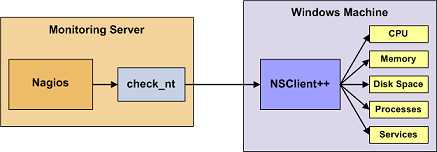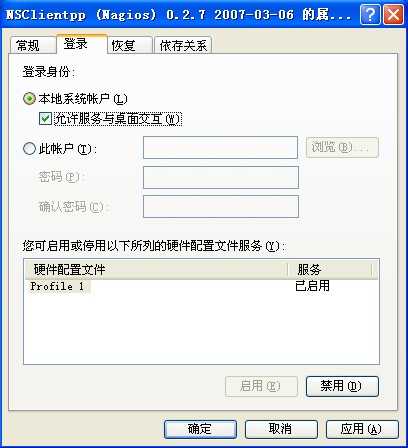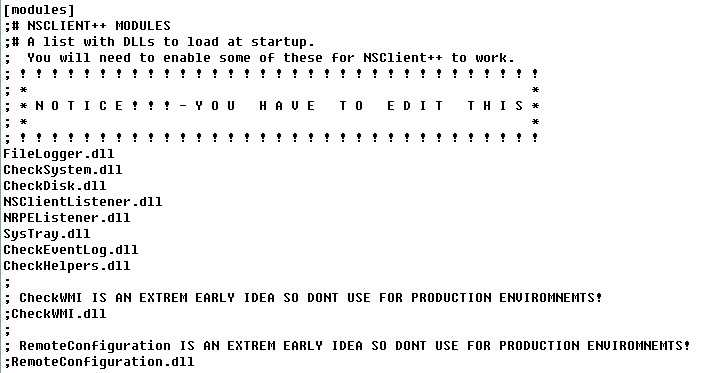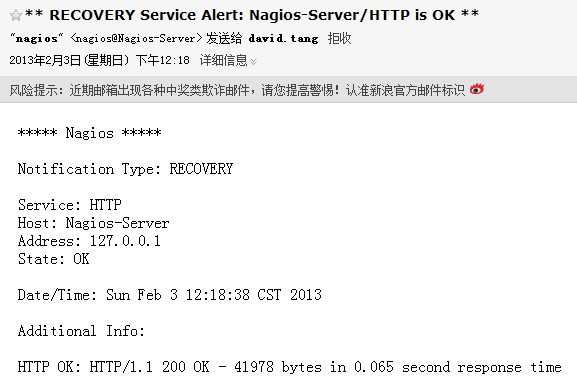标签:
11
+ 环境 虚拟机vmware
+ 操作系统 linux rh5.3
yum install -y gcc glibc glibc-common gd gd-devel xinetd openssl-devel
遇见问题:This system is not registered with RHN
创建Nagios用户和用户组
# useradd -s /sbin/nologin nagios
# mkdir /usr/local/nagios
# chown -R nagios.nagios /usr/local/nagios
# ll -d /usr/local/nagios/编译安装Nagios
# wget http://www.mirrorservice.org/sites/dl.sourceforge.net/pub/sourceforge/n/na/nagios/nagios-3.x/nagios-3.4.3/nagios-3.4.3.tar.gz
# tar zxvf nagios-3.4.3.tar.gz
# cd nagios
# ./configure --prefix=/usr/local/nagios(返回结果包含Review the options above for accuracy. If they look Okay. Type‘make all‘....)
# make all(返回结果包含Enjoy)
# make install(返回结果包含Make[1]:Leaving directory ‘root/nagios‘)
# make install-init(返回结果包含init script installed)
# make install-commandmode(返回结果包含external command directory configured)
# make install-config(返回结果包含config files installed)
# chkconfig --add nagios
# chkconfig --level 35 nagios on
# chkconfig --list nagios(返回结果包含:nagios 0:off 1:off 2:off 3:on 4:on 5:on 6:off)
验证程序是否安装正确
切换目录到安装路径(这里是/usr/local/nagios),看是否存在etc、bin、sbin、share、var 这五个目录,如果存在则可以表明程序被正确的安装到系统了。Nagios 各个目录用途说明如下:
bin Nagios 可执行程序所在目录
etc Nagios 配置文件所在目录
sbin Nagios CGI 文件所在目录,也就是执行外部命令所需文件所在的目录
share Nagios网页文件所在的目录
libexec Nagios 外部插件所在目录
var Nagios 日志文件、lock 等文件所在的目录
var/archives Nagios 日志自动归档目录
var/rw 用来存放外部命令文件的目
安装Nagios插件
wget http://nagios-plugins.org/download/nagios-plugins-1.4.16.tar.gz
# tar zxvf nagios-plugins-1.4.16.tar.gz
# cd nagios-plugins-1.4.16
# ./configure --prefix=/usr/local/nagios
# make && make install
安装和配置Apache和Php
Apache 和Php 不是安装nagios 所必须的,但是nagios提供了web监控界面,通过web监控界面可以清晰的看到被监控主机、资源的运行状态,因此,安装一个web服务是很必要的。
需要注意的是,nagios在nagios3.1.x版本以后,配置web监控界面时需要php的支持。这里我们下载的nagios版本为nagios-3.4.3,因此在编译安装完成apache后,还需要编译php模块,这里选取的php版本为php5.4.10。
# wget http://archive.apache.org/dist/httpd/httpd-2.2.23.tar.gz
# cd httpd-2.2.23
# ./configure --prefix=/usr/local/apache2
# make && make install
* 若出现错误:则在编译时入加 –with-included-apr 即可解决。*
安装Php
# wget http://cn2.php.net/distributions/php-5.4.10.tar.gz
# tar zxvf php-5.4.10.tar.gz
# cd php-5.4.10
# ./configure --prefix=/usr/local/php --with-apxs2=/usr/local/apache2/bin/apxs
# make && make install
出现问题:redhat xml2-config not found,解决方法如下
#yum install libxml2 libxml2-devel (For RedHat & Fedora)
# aptitude install libxml2-dev (For ubuntu)
配置Apache
找到apache 的配置文件/usr/local/apache2/conf/httpd.conf 找到:
User daemon
Group daemon
修改为
User nagios
Group nagios
然后找到
<IfModule dir_module>
DirectoryIndex index.html
</IfModule>
修改为
<IfModule dir_module>
DirectoryIndex index.html index.php
</IfModule>
接着增加如下内容:
AddType application/x-httpd-php .php
为了安全起见,一般情况下要让nagios 的web 监控页面必须经过授权才能访问,这需要增加验证配置,即在httpd.conf 文件最后添加如下信息:
#setting for nagios
ScriptAlias /nagios/cgi-bin "/usr/local/nagios/sbin"
<Directory "/usr/local/nagios/sbin">
AuthType Basic
Options ExecCGI
AllowOverride None
Order allow,deny
Allow from all
AuthName "Nagios Access"
AuthUserFile /usr/local/nagios/etc/htpasswd //用于此目录访问身份验证的文件
Require valid-user
</Directory>
Alias /nagios "/usr/local/nagios/share"
<Directory "/usr/local/nagios/share">
AuthType Basic
Options None
AllowOverride None
Order allow,deny
Allow from all
AuthName "nagios Access"
AuthUserFile /usr/local/nagios/etc/htpasswd
Require valid-user
</Directory>
在上面的配置中,指定了目录验证文件htpasswd,下面要创建这个文件:
# /usr/local/apache2/bin/htpasswd -c /usr/local/nagios/etc/htpasswd david
返回结果会让你输入密码
查看认证文件的内容
# cat /usr/local/nagios/etc/htpasswd
返回结构会有用户名和加密后的密码
# /usr/local/apache2/bin/apachectl start
遇见问题:Cannot load /usr/local/apache2/modules/libphp5.so into server解决方法如下:
原因是Linux有一个SELinux保护模式引起的。
Syntax error on line 268 of /usr/local/apache2/conf/httpd.conf:
Cannot load /usr/local/apache2/modules/libphp5.so into server: /usr/local/apache2/modules/libphp5.so: cannot restore segment prot after reloc: Permission denied
+ 不关闭SELINUX的解决办法:
# setenforce 0
# chcon -c -v -R -u system_u -r object_r -t textrel_shlib_t /usr/local/apache/modules/libphp5.so
# service httpd restart
# setenforce 1
访问
Nagios 主要用于监控一台或者多台本地主机及远程的各种信息,包括本机资源及对外的服务等。默认的Nagios 配置没有任何监控内容,仅是一些模板文件。若要让Nagios 提供服务,就必须修改配置文件,增加要监控的主机和服务,下面将详细介绍。
默认配置文件介绍
Nagios 安装完毕后,默认的配置文件在/usr/local/nagios/etc目录下。
每个文件或目录含义如下表所示:
文件名或目录名 用途
cgi.cfg 控制CGI访问的配置文件
nagios.cfg Nagios 主配置文件
resource.cfg 变量定义文件,又称为资源文件,在些文件中定义变量,以便由其他配置文件引用,如$USER1$
objects objects 是一个目录,在此目录下有很多配置文件模板,用于定义Nagios 对象
objects/commands.cfg 命令定义配置文件,其中定义的命令可以被其他配置文件引用
objects/contacts.cfg 定义联系人和联系人组的配置文件
objects/localhost.cfg 定义监控本地主机的配置文件
objects/printer.cfg 定义监控打印机的一个配置文件模板,默认没有启用此文件
objects/switch.cfg 定义监控路由器的一个配置文件模板,默认没有启用此文件
objects/templates.cfg 定义主机和服务的一个模板配置文件,可以在其他配置文件中引用
objects/timeperiods.cfg 定义Nagios 监控时间段的配置文件
objects/windows.cfg 监控Windows 主机的一个配置文件模板,默认没有启用此文件
在nagios的配置过程中涉及到的几个定义有:主机、主机组,服务、服务组,联系人、联系人组,监控时间,监控命令等,从这些定义可以看出,nagios各个配置文件之间是互为关联,彼此引用的。
成功配置出一台nagios监控系统,必须要弄清楚每个配置文件之间依赖与被依赖的关系,最重要的有四点:
第一:定义监控哪些主机、主机组、服务和服务组;
第二:定义这个监控要用什么命令实现;
第三:定义监控的时间段;
第四:定义主机或服务出现问题时要通知的联系人和联系人组。
配置Nagios
为了能更清楚的说明问题,同时也为了维护方便,建议将nagios各个定义对象创建独立的配置文件:
templates.cfg文件
nagios主要用于监控主机资源以及服务,在nagios配置中称为对象,为了不必重复定义一些监控对象,Nagios引入了一个模板配置文件,将一些共性的属性定义成模板,以便于多次引用。这就是templates.cfg的作用。
下面详细介绍下templates.cfg文件中每个参数的含义:
define contact{
namegeneric-contact; 联系人名称
service_notification_period 24x7; 当服务出现异常时,发送通知的时间段,这个时间段"24x7"在timeperiods.cfg文件中定义
host_notification_period24x7; 当主机出现异常时,发送通知的时间段,这个时间段"24x7"在timeperiods.cfg文件中定义
service_notification_optionsw,u,c,r; 这个定义的是“通知可以被发出的情况”。w即warn,表示警告状态,u即unknown,表示不明状态;
; c即criticle,表示紧急状态,r即recover,表示恢复状态;
; 也就是在服务出现警告状态、未知状态、紧急状态和重新恢复状态时都发送通知给使用者。
host_notification_options d,u,r ; 定义主机在什么状态下需要发送通知给使用者,d即down,表示宕机状态;
; u即unreachable,表示不可到达状态,r即recovery,表示重新恢复状态。
service_notification_commands notify-service-by-email
; 服务故障时,发送通知的方式,可以是邮件和短信,这里发送的方式是邮件;
; 其中“notify-service-by-email”在commands.cfg文件中定义。
host_notification_commands notify-host-by-email
; 主机故障时,发送通知的方式,可以是邮件和短信,这里发送的方式是邮件;
; 其中“notify-host-by-email”在commands.cfg文件中定义。
register0; DONT REGISTER THIS DEFINITION - ITS NOT A REAL CONTACT, JUST A TEMPLATE!
}
define host{
namegeneric-host; 主机名称,这里的主机名,并不是直接对应到真正机器的主机名;
; 乃是对应到在主机配置文件里所设定的主机名。
notifications_enabled 1 ; Host notifications are enabled
event_handler_enabled 1 ; Host event handler is enabled
flap_detection_enabled 1 ; Flap detection is enabled
failure_prediction_enabled 1 ; Failure prediction is enabled
process_perf_data 1 ; 其值可以为0或1,其作用为是否启用Nagios的数据输出功能;
; 如果将此项赋值为1,那么Nagios就会将收集的数据写入某个文件中,以备提取。
retain_status_information 1 ; Retain status information across program restarts
retain_nonstatus_information1 ; Retain non-status information across program restarts
notification_period 24x7; 指定“发送通知”的时间段,也就是可以在什么时候发送通知给使用者。
register0 ; DONT REGISTER THIS DEFINITION - ITS NOT A REAL HOST, JUST A TEMPLATE!
}
define host{
namelinux-server; 主机名称
use generic-host; use表示引用,也就是将主机generic-host的所有属性引用到linux-server中来;
; 在nagios配置中,很多情况下会用到引用。
check_period24x7; 这里的check_period告诉nagios检查主机的时间段
check_interval 5 ; nagios对主机的检查时间间隔,这里是5分钟。
retry_interval 1 ; 重试检查时间间隔,单位是分钟。
max_check_attempts 10 ; nagios对主机的最大检查次数,也就是nagios在检查发现某主机异常时,并不马上判断为异常状况;
; 而是多试几次,因为有可能只是一时网络太拥挤,或是一些其他原因,让主机受到了一点影响;
; 这里的10就是最多试10次的意思。
check_command check-host-alive
; 指定检查主机状态的命令,其中“check-host-alive”在commands.cfg文件中定义。
notification_period 24x7
; 主机故障时,发送通知的时间范围,其中“workhours”在timeperiods.cfg中进行了定义;
; 下面会陆续讲到。
notification_interval 10 ; 在主机出现异常后,故障一直没有解决,nagios再次对使用者发出通知的时间。单位是分钟;
; 如果你觉得,所有的事件只需要一次通知就够了,可以把这里的选项设为0
notification_optionsd,u,r ; 定义主机在什么状态下可以发送通知给使用者,d即down,表示宕机状态;
; u即unreachable,表示不可到达状态;
; r即recovery,表示重新恢复状态。
contact_groups ts ; 指定联系人组,这个“admins”在contacts.cfg文件中定义。
register0 ; DONT REGISTER THIS DEFINITION - ITS NOT A REAL HOST, JUST A TEMPLATE!
}
define host{
namewindows-server ; The name of this host template
use generic-host; Inherit default values from the generic-host template
check_period24x7; By default, Windows servers are monitored round the clock
check_interval 5 ; Actively check the server every 5 minutes
retry_interval 1 ; Schedule host check retries at 1 minute intervals
max_check_attempts 10 ; Check each server 10 times (max)
check_command check-host-alive; Default command to check if servers are "alive"
notification_period 24x7; Send notification out at any time - day or night
notification_interval 10 ; Resend notifications every 30 minutes
notification_optionsd,r ; Only send notifications for specific host states
contact_groups ts ; Notifications get sent to the admins by default
hostgroups windows-servers ; Host groups that Windows servers should be a member of
register0 ; DONT REGISTER THIS - ITS JUST A TEMPLATE
}
define service{
namegeneric-service ; 定义一个服务名称
active_checks_enabled 1 ; Active service checks are enabled
passive_checks_enabled 1 ; Passive service checks are enabled/accepted
parallelize_check 1 ; Active service checks should be parallelized;
; (disabling this can lead to major performance problems)
obsess_over_service 1 ; We should obsess over this service (if necessary)
check_freshness 0 ; Default is to NOT check service ‘freshness‘
notifications_enabled 1 ; Service notifications are enabled
event_handler_enabled 1 ; Service event handler is enabled
flap_detection_enabled 1 ; Flap detection is enabled
failure_prediction_enabled 1 ; Failure prediction is enabled
process_perf_data 1 ; Process performance data
retain_status_information 1 ; Retain status information across program restarts
retain_nonstatus_information1 ; Retain non-status information across program restarts
is_volatile 0 ; The service is not volatile
check_period24x7 ; 这里的check_period告诉nagios检查服务的时间段。
max_check_attempts 3; nagios对服务的最大检查次数。
normal_check_interval 5; 此选项是用来设置服务检查时间间隔,也就是说,nagios这一次检查和下一次检查之间所隔的时间;
; 这里是5分钟。
retry_check_interval2; 重试检查时间间隔,单位是分钟。
contact_groups ts ; 指定联系人组
notification_optionsw,u,c,r ; 这个定义的是“通知可以被发出的情况”。w即warn,表示警告状态;
; u即unknown,表示不明状态;
; c即criticle,表示紧急状态,r即recover,表示恢复状态;
; 也就是在服务出现警告状态、未知状态、紧急状态和重新恢复后都发送通知给使用者。
notification_interval 10 ; Re-notify about service problems every hour
notification_period 24x7 ; 指定“发送通知”的时间段,也就是可以在什么时候发送通知给使用者。
register0; DONT REGISTER THIS DEFINITION - ITS NOT A REAL SERVICE, JUST A TEMPLATE!
}
define service{
namelocal-service ; The name of this service template
use generic-service ; Inherit default values from the generic-service definition
max_check_attempts 4 ; Re-check the service up to 4 times in order to determine its final (hard) state
normal_check_interval 5 ; Check the service every 5 minutes under normal conditions
retry_check_interval1 ; Re-check the service every minute until a hard state can be determined
register0 ; DONT REGISTER THIS DEFINITION - ITS NOT A REAL SERVICE, JUST A TEMPLATE!
}
resource.cfg文件
resource.cfg是nagios的变量定义文件,文件内容只有一行:
$USER1$=/usr/local/nagios/libexec
其中,变量
此文件默认是存在的,无需修改即可使用,当然如果有新的命令需要加入时,在此文件进行添加即可。
#notify-host-by-email命令的定义
define command{
command_namenotify-host-by-email #命令名称,即定义了一个主机异常时发送邮件的命令。
command_line/usr/bin/printf "%b" "***** Nagios *****\n\nNotification Type: $NOTIFICATIONTYPE$\nHost: $HOSTNAME$\nState: $HOSTSTATE$\nAddress: $HOSTADDRESS$\nInfo: $HOSTOUTPUT$\n\nDate/Time: $LONGDATETIME$\n" | /bin/mail -s "** $NOTIFICATIONTYPE$ Host Alert: $HOSTNAME$ is $HOSTSTATE$ **" $CONTACTEMAIL$ #命令具体的执行方式。
}
#notify-service-by-email命令的定义
define command{
command_namenotify-service-by-email #命令名称,即定义了一个服务异常时发送邮件的命令
command_line/usr/bin/printf "%b" "***** Nagios *****\n\nNotification Type: $NOTIFICATIONTYPE$\n\nService: $SERVICEDESC$\nHost: $HOSTALIAS$\nAddress: $HOSTADDRESS$\nState: $SERVICESTATE$\n\nDate/Time: $LONGDATETIME$\n\nAdditional Info:\n\n$SERVICEOUTPUT$\n" | /bin/mail -s "** $NOTIFICATIONTYPE$ Service Alert: $HOSTALIAS$/$SERVICEDESC$ is $SERVICESTATE$ **" $CONTACTEMAIL$
}
#check-host-alive命令的定义
define command{
command_namecheck-host-alive #命令名称,用来检测主机状态。
command_line$USER1$/check_ping -H $HOSTADDRESS$ -w 3000.0,80% -c 5000.0,100% -p 5
# 这里的变量$USER1$在resource.cfg文件中进行定义,即$USER1$=/usr/local/nagios/libexec;
# 那么check_ping的完整路径为/usr/local/nagios/libexec/check_ping;
# “-w 3000.0,80%”中“-w”说明后面的一对值对应的是“WARNING”状态,“80%”是其临界值。
# “-c 5000.0,100%”中“-c”说明后面的一对值对应的是“CRITICAL”,“100%”是其临界值。
# “-p 1”说明每次探测发送一个包。
}
define command{
command_namecheck_local_disk
command_line$USER1$/check_disk -w $ARG1$ -c $ARG2$ -p $ARG3$#$ARG1$是指在调用这个命令的时候,命令后面的第一个参数。
}
define command{
command_namecheck_local_load
command_line$USER1$/check_load -w $ARG1$ -c $ARG2$
}
define command{
command_namecheck_local_procs
command_line$USER1$/check_procs -w $ARG1$ -c $ARG2$ -s $ARG3$
}
define command{
command_namecheck_local_users
command_line$USER1$/check_users -w $ARG1$ -c $ARG2$
}
define command{
command_namecheck_local_swap
command_line$USER1$/check_swap -w $ARG1$ -c $ARG2$
}
define command{
command_namecheck_ftp
command_line$USER1$/check_ftp -H $HOSTADDRESS$ $ARG1$
}
define command{
command_namecheck_http
command_line$USER1$/check_http -I $HOSTADDRESS$ $ARG1$
}
define command{
command_namecheck_ssh
command_line$USER1$/check_ssh $ARG1$ $HOSTADDRESS$
}
define command{
command_namecheck_ping
command_line$USER1$/check_ping -H $HOSTADDRESS$ -w $ARG1$ -c $ARG2$ -p 5
}
define command{
command_namecheck_nt
command_line$USER1$/check_nt -H $HOSTADDRESS$ -p 12489 -v $ARG1$ $ARG2$
}
此文件默认不存在,需要手动创建,hosts.cfg主要用来指定被监控的主机地址以及相关属性信息,根据实验目标配置如下:
define host{
use linux-server #引用主机linux-server的属性信息,linux-server主机在templates.cfg文件中进行了定义。
host_name Nagios-Linux #主机名
alias Nagios-Linux #主机别名
address 192.168.1.111 #被监控的主机地址,这个地址可以是ip,也可以是域名。
}
#定义一个主机组
define hostgroup{
hostgroup_name bsmart-servers#主机组名称,可以随意指定。
alias bsmart servers#主机组别名
members Nagios-Linux #主机组成员,其中“Nagios-Linux”就是上面定义的主机。
}
注意:在/usr/local/nagios/etc/objects 下默认有localhost.cfg 和windows.cfg 这两个配置文件,localhost.cfg 文件是定义监控主机本身的,windows.cfg 文件是定义windows 主机的,其中包括了对host 和相关services 的定义。所以在本次实验中,将直接在localhost.cfg 中定义监控主机(Nagios-Server),在windows.cfg中定义windows 主机(Nagios-Windows)。根据自己的需要修改其中的相关配置,详细如下:
localhost.cfg
define host{
use linux-server; Name of host template to use
; This host definition will inherit all variables that are defined
; in (or inherited by) the linux-server host template definition.
host_name Nagios-Server
alias Nagios-Server
address 127.0.0.1
}
define hostgroup{
hostgroup_name linux-servers ; The name of the hostgroup
alias Linux Servers ; Long name of the group
members Nagios-Server ; Comma separated list of hosts that belong to this group
}
define service{
use local-service ; Name of service template to use
host_name Nagios-Server
service_description PING
check_command check_ping!100.0,20%!500.0,60%
}
define service{
use local-service ; Name of service template to use
host_name Nagios-Server
service_description Root Partition
check_command check_local_disk!20%!10%!/
}
define service{
use local-service ; Name of service template to use
host_name Nagios-Server
service_description Current Users
check_command check_local_users!20!50
}
define service{
use local-service ; Name of service template to use
host_name Nagios-Server
service_description Total Processes
check_command check_local_procs!250!400!RSZDT
}
define service{
use local-service ; Name of service template to use
host_name Nagios-Server
service_description Current Load
check_command check_local_load!5.0,4.0,3.0!10.0,6.0,4.0
}
define service{
use local-service ; Name of service template to use
host_name Nagios-Server
service_description Swap Usage
check_command check_local_swap!20!10
}
define service{
use local-service ; Name of service template to use
host_name Nagios-Server
service_description SSH
check_command check_ssh
notifications_enabled 0
}
define service{
use local-service ; Name of service template to use
host_name Nagios-Server
service_description HTTP
check_command check_http
notifications_enabled 0
}
windows.cfg
define host{
use windows-server ; Inherit default values from a template
host_name Nagios-Windows ; The name we‘re giving to this host
alias My Windows Server ; A longer name associated with the host
address 192.168.1.113 ; IP address of the host
}
define hostgroup{
hostgroup_name windows-servers ; The name of the hostgroup
alias Windows Servers ; Long name of the group
}
define service{
use generic-service
host_name Nagios-Windows
service_description NSClient++ Version
check_command check_nt!CLIENTVERSION
}
define service{
use generic-service
host_name Nagios-Windows
service_description Uptime
check_command check_nt!UPTIME
}
define service{
use generic-service
host_name Nagios-Windows
service_description CPU Load
check_command check_nt!CPULOAD!-l 5,80,90
}
define service{
use generic-service
host_name Nagios-Windows
service_description Memory Usage
check_command check_nt!MEMUSE!-w 80 -c 90
}
define service{
use generic-service
host_name Nagios-Windows
service_description C:\ Drive Space
check_command check_nt!USEDDISKSPACE!-l c -w 80 -c 90
}
define service{
use generic-service
host_name Nagios-Windows
service_description W3SVC
check_command check_nt!SERVICESTATE!-d SHOWALL -l W3SVC
}
define service{
use generic-service
host_name Nagios-Windows
service_description Explorer
check_command check_nt!PROCSTATE!-d SHOWALL -l Explorer.exe
}
此文件默认也不存在,需要手动创建,services.cfg文件主要用于定义监控的服务和主机资源,例如监控http服务、ftp服务、主机磁盘空间、主机系统负载等等。Nagios-Server 和Nagios-Windows 相关服务已在相应的配置文件中定义,所以这里只需要定义Nagios-Linux 相关服务即可,这里只定义一个检测是否存活的服务来验证配置文件的正确性,其他服务的定义将在后面讲到。
define service{
use local-service #引用local-service服务的属性值,local-service在templates.cfg文件中进行了定义。
host_name Nagios-Linux #指定要监控哪个主机上的服务,“Nagios-Server”在hosts.cfg文件中进行了定义。
service_description check-host-alive #对监控服务内容的描述,以供维护人员参考。
check_command check-host-alive #指定检查的命令。
}
contacts.cfg是一个定义联系人和联系人组的配置文件,当监控的主机或者服务出现故障,nagios会通过指定的通知方式(邮件或者短信)将信息发给这里指定的联系人或者使用者。
define contact{
contact_name David #联系人的名称,这个地方不要有空格
use generic-contact #引用generic-contact的属性信息,其中“generic-contact”在templates.cfg文件中进行定义
alias Nagios Admin
email david.tang@bsmart.cn
}
define contactgroup{
contactgroup_name ts #联系人组的名称,同样不能空格
alias Technical Support #联系人组描述
members David #联系人组成员,其中“david”就是上面定义的联系人,如果有多个联系人则以逗号相隔
}
timeperiods.cfg文件
此文件只要用于定义监控的时间段,下面是一个配置好的实例:
#下面是定义一个名为24x7的时间段,即监控所有时间段
define timeperiod{
timeperiod_name 24x7 #时间段的名称,这个地方不要有空格
alias 24 Hours A Day, 7 Days A Week
sunday 00:00-24:00
monday 00:00-24:00
tuesday 00:00-24:00
wednesday 00:00-24:00
thursday00:00-24:00
friday 00:00-24:00
saturday00:00-24:00
}
#下面是定义一个名为workhours的时间段,即工作时间段。
define timeperiod{
timeperiod_name workhours
alias Normal Work Hours
monday 09:00-17:00
tuesday 09:00-17:00
wednesday 09:00-17:00
thursday09:00-17:00
friday 09:00-17:00
}
cgi.cfg文件
此文件用来控制相关cgi脚本,如果想在nagios的web监控界面执行cgi脚本,例如重启nagios进程、关闭nagios通知、停止nagios主机检测等,这时就需要配置cgi.cfg文件了。
由于nagios的web监控界面验证用户为david,所以只需在cgi.cfg文件中添加此用户的执行权限就可以了,需要修改的配置信息如下:
default_user_name=david
authorized_for_system_information=nagiosadmin,david
authorized_for_configuration_information=nagiosadmin,david
authorized_for_system_commands=david
authorized_for_all_services=nagiosadmin,david
authorized_for_all_hosts=nagiosadmin,david
authorized_for_all_service_commands=nagiosadmin,david
authorized_for_all_host_commands=nagiosadmin,david
nagios.cfg文件
nagios.cfg默认的路径为/usr/local/nagios/etc/nagios.cfg,是nagios的核心配置文件,所有的对象配置文件都必须在这个文件中进行定义才能发挥其作用,这里只需将对象配置文件在Nagios.cfg文件中进行引用即可。
log_file=/usr/local/nagios/var/nagios.log # 定义nagios日志文件的路径
cfg_file=/usr/local/nagios/etc/objects/commands.cfg# “cfg_file”变量用来引用对象配置文件,如果有更多的对象配置文件,在这里依次添加即可。
cfg_file=/usr/local/nagios/etc/objects/contacts.cfg
cfg_file=/usr/local/nagios/etc/objects/hosts.cfg
cfg_file=/usr/local/nagios/etc/objects/services.cfg
cfg_file=/usr/local/nagios/etc/objects/timeperiods.cfg
cfg_file=/usr/local/nagios/etc/objects/templates.cfg
cfg_file=/usr/local/nagios/etc/objects/localhost.cfg # 本机配置文件
cfg_file=/usr/local/nagios/etc/objects/windows.cfg # windows 主机配置文件
object_cache_file=/usr/local/nagios/var/objects.cache # 该变量用于指定一个“所有对象配置文件”的副本文件,或者叫对象缓冲文件
precached_object_file=/usr/local/nagios/var/objects.precache
resource_file=/usr/local/nagios/etc/resource.cfg # 该变量用于指定nagios资源文件的路径,可以在nagios.cfg中定义多个资源文件。
status_file=/usr/local/nagios/var/status.dat # 该变量用于定义一个状态文件,此文件用于保存nagios的当前状态、注释和宕机信息等。
status_update_interval=10 # 该变量用于定义状态文件(即status.dat)的更新时间间隔,单位是秒,最小更新间隔是1秒。
nagios_user=nagios # 该变量指定了Nagios进程使用哪个用户运行。
nagios_group=nagios# 该变量用于指定Nagios使用哪个用户组运行。
check_external_commands=1 # 该变量用于设置是否允许nagios在web监控界面运行cgi命令;
# 也就是是否允许nagios在web界面下执行重启nagios、停止主机/服务检查等操作;
# “1”为运行,“0”为不允许。
command_check_interval=10s # 该变量用于设置nagios对外部命令检测的时间间隔,如果指定了一个数字加一个"s"(如10s);
# 那么外部检测命令的间隔是这个数值以秒为单位的时间间隔;
# 如果没有用"s",那么外部检测命令的间隔是以这个数值的“时间单位”的时间间隔。
interval_length=60 # 该变量指定了nagios的时间单位,默认值是60秒,也就是1分钟;
# 即在nagios配置中所有的时间单位都是分钟。
验证Nagios 配置文件的正确性
Nagios 在验证配置文件方面做的非常到位,只需通过一个命令即可完成:
# /usr/local/nagios/bin/nagios -v /usr/local/nagios/etc/nagios.cfg
Nagios提供的这个验证功能非常有用,在错误信息中通常会打印出错误的配置文件以及文件中的哪一行,这使得nagios的配置变得非常容易,报警信息通常是可以忽略的,因为一般那些只是建议性的。
看到上面这些信息就说明没问题了,然后启动Nagios 服务。
A. 启动Nagios
a. 通过初始化脚本启动nagios
# /etc/init.d/nagios start
or
# service nagios start
b. 手工方式启动nagios
通过nagios命令的“-d”参数来启动nagios守护进程:
# /usr/local/nagios/bin/nagios -d /usr/local/nagios/etc/nagios.cfg
B.重启Nagios
当修改了配置文件让其生效时,需要重启/重载Nagios服务。
a. 通过初始化脚本来重启nagios
# /etc/init.d/nagios reload
or
# /etc/init.d/nagios restart
or
# service nagios restart
b. 通过web监控页重启nagios
可以通过web监控页的 “Process Info” -> “Restart the Nagios process”来重启nagios
c. 手工方式平滑重启
# kill -HUP <nagios_pid>
C 停止Nagios
a. 通过初始化脚本关闭nagios服务
# /etc/init.d/nagios stop
or
# service nagios stop
b. 通过web监控页停止nagios
可以通过web监控页的 “Process Info” -> “Shutdown the Nagios process”来停止nagios
c. 手工方式停止Nagios
# kill <nagios_pid>
A 启动完成之后,登录Nagios Web监控页http://192.168.1.108/nagios/ 查看相关信息。
B 点击左面的Current Status -> Hosts 可以看到所定义的三台主机已经全部UP了。
C 点击Current Status -> Services 查看服务监控情况。
看到Nagios-Linux和Nagios-Server的服务状态已经OK了,但是Nagios-Windows的服务状态为CRITICAL,Status Information 提示Connection refused。因为Nagios-Windows上还未安装插件,内部服务还无法查看,所以出现这种情况。将在下面具体讲解。
上面已经对远程Linux 主机是否存活做了监控,而判断远程机器是否存活,我们可以使用ping 工具对其监测。还有一些远程主机服务,例如ftp、ssh、http,都是对外开放的服务,即使不用Nagios,我们也可以试的出来,随便找一台机器看能不能访问这些服务就行了。但是对于像磁盘容量,cpu负载这样的“本地信息”,Nagios只能监测自己所在的主机,而对其他的机器则显得有点无能为力。毕竟没得到被控主机的适当权限是不可能得到这些信息的。为了解决这个问题,nagios有这样一个附加组件–“NRPE”,用它就可以完成对Linux 类型主机”本地信息”的监控。
A NRPE 工作原理

NRPE 总共由两部分组成:
check_nrpe 插件,位于监控主机上
NRPE daemon,运行在远程的Linux主机上(通常就是被监控机)
按照上图,整个的监控过程如下:
当Nagios 需要监控某个远程Linux 主机的服务或者资源情况时:
Nagios 会运行check_nrpe 这个插件,告诉它要检查什么;
check_nrpe 插件会连接到远程的NRPE daemon,所用的方式是SSL;
NRPE daemon 会运行相应的Nagios 插件来执行检查;
NRPE daemon 将检查的结果返回给check_nrpe 插件,插件将其递交给nagios做处理。
注意:NRPE daemon 需要Nagios 插件安装在远程的Linux主机上,否则,daemon不能做任何的监控。
B 在被监控机(Nagios-Linux)上
a. 增加用户&设定密码
# useradd nagios
# passwd nagios
b. 安装Nagios 插件
# tar zxvf nagios-plugins-1.4.16.tar.gz
# cd nagios-plugins-1.4.16
# ./configure --prefix=/usr/local/nagios
# make && make install
这一步完成后会在/usr/local/nagios/下生成三个目录include、libexec和share。
修改目录权限
# chown nagios.nagios /usr/local/nagios
# chown -R nagios.nagios /usr/local/nagios/libexec
c. 安装NRPE
# wget http://prdownloads.sourceforge.net/sourceforge/nagios/nrpe-2.13.tar.gz
# tar zxvf nrpe-2.13.tar.gz
# cd nrpe-2.13
# ./configure
# make all
接下来安装NPRE插件,daemon和示例配置文件。
c.1 安装check_nrpe 这个插件
# make install-plugin
监控机需要安装check_nrpe 这个插件,被监控机并不需要,我们在这里安装它只是为了测试目的。
c.2 安装deamon
# make install-daemon
c.3 安装配置文件
# make install-daemon-config
现在再查看nagios 目录就会发现有5个目录了
按照安装文档的说明,是将NRPE deamon作为xinetd下的一个服务运行的。在这样的情况下xinetd就必须要先安装好,不过一般系统已经默认安装了。
d. 安装xinted 脚本
# make install-xinetd
可以看到创建了这个文件/etc/xinetd.d/nrpe。
编辑这个脚本:
在only_from 后增加监控主机的IP地址。
编辑/etc/services 文件,增加NRPE服务
重启xinted 服务
# service xinetd restart
查看NRPE 是否已经启动
可以看到5666端口已经在监听了。
e. 测试NRPE是否则正常工作
使用上面在被监控机上安装的check_nrpe 这个插件测试NRPE 是否工作正常。
# /usr/local/nagios/libexec/check_nrpe -H localhost
会返回当前NRPE的版本
也就是在本地用check_nrpe连接nrpe daemon是正常的。
注:为了后面工作的顺利进行,注意本地防火墙要打开5666能让外部的监控机访问。
f. check_nrpe 命令用法
查看check_nrpe 命令用法
# /usr/local/nagios/libexec/check_nrpe –h
可以看到用法是:
check_nrpe –H 被监控的主机 -c 要执行的监控命令
注意:-c 后面接的监控命令必须是nrpe.cfg 文件中定义的。也就是NRPE daemon只运行nrpe.cfg中所定义的命令。
g. 查看NRPE的监控命令
# cd /usr/local/nagios/etc
# cat nrpe.cfg |grep -v "^#"|grep -v "^$"
[root@Nagiso-Linux etc]# cat nrpe.cfg |grep -v "^#"|grep -v "^$"
log_facility=daemon
pid_file=/var/run/nrpe.pid
server_port=5666
nrpe_user=nagios
nrpe_group=nagios
allowed_hosts=127.0.0.1
dont_blame_nrpe=0
debug=0
command_timeout=60
connection_timeout=300
command[check_users]=/usr/local/nagios/libexec/check_users -w 5 -c 10
command[check_load]=/usr/local/nagios/libexec/check_load -w 15,10,5 -c 30,25,20
command[check_sda1]=/usr/local/nagios/libexec/check_disk -w 20% -c 10% -p /dev/sda1
command[check_zombie_procs]=/usr/local/nagios/libexec/check_procs -w 5 -c 10 -s Z
command[check_total_procs]=/usr/local/nagios/libexec/check_procs -w 150 -c 200
[root@Nagiso-Linux etc]#
红色部分是命令名,也就是check_nrpe 的-c 参数可以接的内容,等号 “=” 后面是实际执行的插件程序(这与commands.cfg 中定义命令的形式十分相似,只不过是写在了一行)。也就是说check_users 就是等号后面/usr/local/nagios/libexec/check_users -w 5 -c 10 的简称。
我们可以很容易知道上面这5行定义的命令分别是检测登陆用户数,cpu负载,sda1的容量,僵尸进程,总进程数。各条命令具体的含义见插件用法(执行“插件程序名 –h”)。
由于-c 后面只能接nrpe.cfg 中定义的命令,也就是说现在我们只能用上面定义的这五条命令。我们可以在本机实验一下。
http://images.cnitblog.com/blog/370046/201302/02162617-1c0b8b7a4b554f58903459594c7c1e5c.jpg“/>
C 在监控主机(Nagios-Server)上
之前已经将Nagios运行起来了,现在要做的事情是:
安装check_nrpe 插件;
在commands.cfg 中创建check_nrpe 的命令定义,因为只有在commands.cfg 中定义过的命令才能在services.cfg 中使用;
创建对被监控主机的监控项目;
a 安装check_nrpe 插件
# tar zxvf nrpe-2.13.tar.gz
# cd nrpe-2.13
# ./configure
# make all
# make install-plugin
只运行这一步就行了,因为只需要check_nrpe插件。
在Nagios-Linux 上我们已经装好了nrpe,现在我们测试一下监控机使用check_nrpe 与被监控机运行的nrpe daemon之间的通信。

看到已经正确返回了NRPE的版本信息,说明一切正常。
b 在commands.cfg中增加对check_nrpe的定义
# vi /usr/local/nagios/etc/objects/commands.cfg
在最后面增加如下内容:

意义如下:
define command{
command_namecheck_nrpe # 定义命令名称为check_nrpe,在services.cfg中要使用这个名称.
command_line
}
-c 后面带的
9.3.3 定义对Nagios-Linux 主机的监控
下面就可以在services.cfg 中定义对Nagios-Linux 主机的监控了。
define service{
use local-service
host_name Nagios-Linux
service_description Current Load
check_command check_nrpe!check_load
}
define service{
use local-service
host_name Nagios-Linux
service_description Check Disk sda1
check_command check_nrpe!check_sda1
}
define service{
use local-service
host_name Nagios-Linux
service_description Total Processes
check_command check_nrpe!check_total_procs
}
define service{
use local-service
host_name Nagios-Linux
service_description Current Users
check_command check_nrpe!check_users
}
define service{
use local-service
host_name Nagios-Linux
service_description Check Zombie Procs
check_command check_nrpe!check_zombie_procs
}
还有一个任务是要监控Nagios-Linux 的swap 使用情况。但是在nrpe.cfg 中默认没有定义这个监控功能的命令。怎么办?手动在nrpe.cfg 中添加,也就是自定义NRPE命令。
现在我们要监控swap 分区,如果空闲空间小于20%则为警告状态 -> warning;如果小于10%则为严重状态 -> critical。我们可以查得需要使用check_swap插件,完整的命令行应该是下面这样。
# /usr/local/nagios/libexec/check_swap -w 20% -c 10%
在被监控机(Nagios-Linux)上增加check_swap 命令的定义
# vi /usr/local/nagios/etc/nrpe.cfg
增加下面这一行
command[check_swap]=/usr/local/nagios/libexec/check_swap -w 20% -c 10%
我们知道check_swap 现在就可以作为check_nrpe 的-c 的参数使用了
修改了配置文件,当然要重启。
如果你是以独立的daemon运行的nrpe,那么需要手动重启;如果你是在xinetd 下面运行的,则不需要。
由于本实验中nrpe 是xinetd 下运行的,所以不需要重启服务。
在监控机(Nagios-Server)上增加这个check_swap 监控项目
define service{
use local-service
host_name Nagios-Linux
service_description Check Swap
check_command check_nrpe!check_swap
}
同理,Nagios-Linux 上我还开启了http 服务,需要监控一下,按照上面的做法,在被监控机(Nagios-Linux)上增加check_http 命令的定义
# vi /usr/local/nagios/etc/nrpe.cfg
增加下面这一行
command[check_http]=/usr/local/nagios/libexec/check_http -I 127.0.0.1
在监控机(Nagios-Server)上增加check_http 监控项目
define service{
use local-service
host_name Nagios-Linux
service_description HTTP
check_command check_nrpe!check_http
}
所有的配置文件已经修改好了,现在重启Nagios。
# service nagios restart

可以看到,对于Nagios-Server 和Nagios-Linux 上的相关服务的监控已经成功了,还有Nagios-Windows 上的服务还没有定义,下面讲到。
在Nagios的libexec下有check_nt这个插件,它就是用来检查windows机器的服务的。其功能类似于check_nrpe。不过还需要搭配另外一个软件NSClient++,它则类似于NRPE。
NSClient++的原理如下图

可以看到NSClient与nrpe最大的区别就是:
被监控机上安装有nrpe,并且还有插件,最终的监控是由这些插件来进行的。当监控主机将监控请求发给nrpe后,nrpe调用插件来完成监控。
NSClient++则不同,被监控机上只安装NSClient,没有任何的插件。当监控主机将监控请求发给NSClient++后,NSClient直接完成监控,所有的监控是由NSClient完成的。
这也说明了NSClient++的一个很大的问题:不灵活、没有可扩展性。它只能完成自己本身包含的监控操作,不能由一些插件来扩展。好在NSClient++已经做的不错了,基本上可以完全满足我们的监控需求。
a 安装NSClient++
从http://www.nsclient.org/nscp/downloads 下载NSClient++-0.2.7.zip
解压到C盘根目录。
打开cmd 切换到c:\NSClient++-0.2.7
执行nsclient++ /install 进行安装
执行nsclient++ SysTray (注意大小写),这一步是安装系统托盘,时间稍微有点长。
在运行里面输入services.msc 打开“服务”
看到下图就说明NSClient服务已经安装上了

双击打开,点“登录”标签,在“允许服务与桌面交互”前打勾。

编辑c:\NSClient++-0.2.7下的NSC.ini文件。
将 [modules]部分的所有模块前面的注释都去掉,除了CheckWMI.dll 和 RemoteConfiguration.dll 这两个。

在[Settings]部分设置’password’选项来设置密码,作用是在nagios连接过来时要求提供密码。这一步是可选的,我这里设置为’123456’。
将[Settings]部分’allowed_hosts’选项的注释去掉,并且加上运行nagios的监控主机的IP。各IP之间以逗号相隔。这个地方是支持子网的,如果写成192.168.1.0/24则表示该子网内的所有机器都可以访问。如果这个地方是空白则表示所有的主机都可以连接上来。
注意是[Settings]部分的,因为[NSClient]部分也有这个选项。

必须保证[NSClient]的’port’选项并没有被注释,并且它的值是’12489’,这是NSClient的默认监听端口。

在cmd 中执行nsclient++ /start启动服务,注意所在目录是c:\NSClient++-0.2.7
这时在桌面右下角的系统托盘处会出现一个黄色的M字样的图标

查看服务

已经正常启动了。
注意服务默认设的是“自动”,也就是说是开机自动启动的。
在cmd 里面执行netstat –an 可以看到已经开始监听tcp的12489端口了。
这样外部就可以访问了吗?
错!
防火墙也要打开tcp的12489端口,否则nagios 检查此服务的时候会报错。
这样被监控机的配置就搞定了,它就等待nagios 发出某个监控请求,然后它执行请求将监控的结果发回到nagios监控主机上。
之前已经在监控主机(Nagios-Server)上对Windows 主机的监控做了配置,但是commands.cfg 中默认没有设置密码项,所以要修改一下,增加”-s 123456”,如下:
# ‘check_nt‘ command definition
define command{
command_namecheck_nt
command_line$USER1$/check_nt -H $HOSTADDRESS$ -p 12489 -s 123456 -v $ARG1$ $ARG2$
}
现在打开Nagios Web监控页便可查看到相关信息了。
可以看到有错误:NSClient - ERROR: PDH Collection thread not running.
Google 一下,是由于操作系统语言的问题,好像NSClient 默认支持的语言并不多,具体可以百度一下。
查看NSClient的日志C:\NSClient++-0.2.7\nsclient.log,信息如下:
2013-02-02 22:05:30: error:.\PDHCollector.cpp:98: You need to manually configure performance counters!
需要手动配置performance counters。
打开C:\NSClient++-0.2.7\counters.defs文件,复制文件里面”English US”那部分内容,粘贴到counters.defs 文件的最后,修改Description = “Chinese”。
修改完之后,在mmc中重启NSClient 服务。
然后查看日志,内容如下:

执行成功,但是W3SVC服务为Unknown 状态。查资料,需要开启Windows 的IIS服务。
打开“控制面板”进行安装。
安装完毕后,再到Nagios Web监控页查看,全部监控正常。
a 安装sendmail 组件
首先要确保sendmail 相关组件的完整安装,我们可以使用如下的命令来完成sendmail 的安装:
然后重新启动sendmail服务:
然后发送测试邮件,验证sendmail的可用性:
b 邮件报警的配置
在上面我们已经简单配置过了/usr/local/nagios/etc/objects/contacts.cfg 文件,Nagios 会将报警邮件发送到配置文件里的E-mail 地址。
c Nagios 通知
PROBLEM


Linux下Nagios安装配置完毕。
参考资料
标签:
原文地址:http://blog.csdn.net/crisschan/article/details/51382680